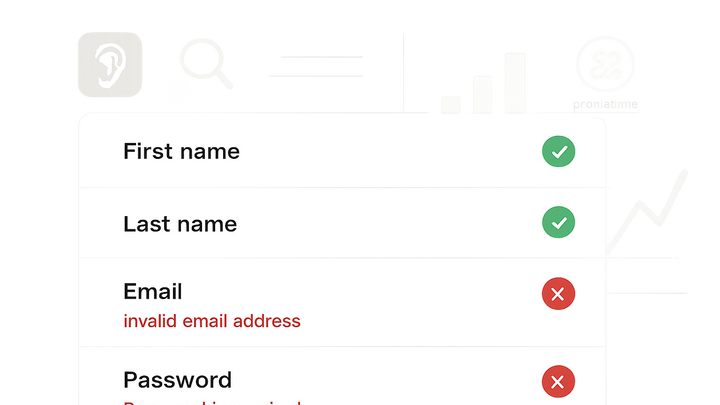Published on 2025-06-29T21:54:20Z
What is Form Validation? Examples for CRO, UX & SEO
Form Validation is the process of checking user input on web forms to ensure data accuracy and completeness before submission. It plays a crucial role in conversion rate optimization (CRO), user experience (UX), search engine optimization (SEO), and accessibility. By validating input fields—such as email addresses, phone numbers, and passwords—websites prevent invalid data, reduce user frustration, and guide visitors smoothly through the form-filling process. Effective validation can occur on the client side (in the browser) or server side, using HTML5 attributes, custom JavaScript, or specialized libraries. Real-time feedback helps users correct mistakes instantly, lowering abandonment rates and boosting lead generation. Accessible error messages with ARIA roles ensure screen readers announce issues clearly, making forms usable for everyone. Tools like Prevue.me automate validation audits, surfacing actionable critiques to improve field rules, UX flows, and SEO performance.
Form validation
Checks user input on web forms for accuracy, improving UX, conversion rates, SEO, and accessibility by catching errors before submission.
Why Form Validation Matters
Form validation is vital for ensuring a smooth, error-free experience that drives conversions and maintains data integrity.
-
Boosting conversion rates
By preventing invalid submissions and reducing error-related frustration, form validation keeps users engaged, increasing successful completions and lead generation.
-
Reducing user friction
Immediate feedback on input errors helps users correct mistakes on the spot, streamlining the form-filling process and reducing drop-off.
-
Ensuring data quality
Validation enforces correct formats and required fields, ensuring that the data collected is reliable and usable for analytics and business decisions.
-
Improving accessibility & seo
Clear, accessible error messages and proper validation markup support screen readers and reduce bounce rates, which can indirectly boost search engine rankings.
- Aria live regions:
Use ARIA roles like alert to automatically announce validation errors to assistive technologies.
- Descriptive error messages:
Provide specific guidance on how to fix errors, benefiting both users and search engine crawlers through improved engagement.
- Aria live regions:
Types of Form Validation
Form validation can be implemented at various layers, each with its advantages and best-use scenarios.
-
Client-side validation
Runs in the user’s browser using HTML5 attributes or JavaScript, offering real-time feedback without server round trips.
-
Server-side validation
Occurs on the server after form submission, ensuring security by double-checking data and preventing bypass of client-side checks.
-
Html5 built-in validation
Leverages native HTML5 form attributes like required, pattern, min, and max to enforce basic input rules without custom scripts.
-
Custom javascript validation
Allows complex rules and dynamic feedback using code or libraries; ideal for specialized patterns and interactive UI behaviors.
- Regex patterns:
Use regular expressions to define strict formats, such as phone numbers or postal codes.
- Validation libraries:
Employ tools like Parsley.js or Validate.js to simplify rule creation and error handling.
- Regex patterns:
Best Practices for Effective Form Validation
Following established guidelines ensures validation enhances rather than hinders user experience and performance.
-
Provide real-time feedback
Validate inputs as users type or on focus change, allowing quick corrections without waiting for form submission.
-
Keep error messages clear and specific
Use plain language to explain what went wrong and how to fix it, avoiding technical jargon that may confuse users.
-
Use visual cues and aria roles
Combine color, icons, and ARIA attributes to highlight errors and help assistive technologies announce them properly.
- Accessible aria roles:
Apply roles like alert or aria-invalid to ensure screen readers detect validation errors.
- Visual indicators:
Use contrasting colors, icons, and clear focus outlines to draw attention to problematic fields.
- Accessible aria roles:
-
Validate on submission and change
Implement both on-the-fly checks and final validation when submitting to catch overlooked issues and reinforce rules.
Implementing Form Validation with Prevue.me
prevue.me automates form validation audits, offering actionable recommendations to optimize your form fields for conversion, UX, and accessibility.
-
Automated validation audits
prevue.me scans your forms to identify missing validations, inconsistent rules, and potential user friction points.
-
Actionable feedback for ux & accessibility
Receive step-by-step suggestions to improve field labeling, error handling, ARIA attributes, and mobile responsiveness.
- Ux improvement:
Recommendations to streamline input sequences and provide inline help text.
- Accessibility fixes:
Guidance on ARIA roles, focus management, and screen reader compatibility.
- Ux improvement:
-
Seo impacts of validation errors
Understand how validation issues can lead to higher abandonment, affecting dwell time and indirectly impacting search rankings.
